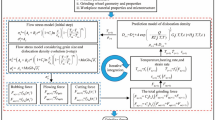Abstract
Contact calculation is of great importance in predicting the material removal (MR) of flexible grinding process (FGP). The contact is mostly considered approximately constant in the existing MR models, while the situations that contact varies a lot after FGP are ignored. Therefore, a novel model is proposed in this paper to take those situations into consideration. Firstly, the nonconstant-contact situation is introduced. Then, an equivalent method is developed to convert the nonconstant-contact grinding process into the accumulation of several quasi-constant-contact grinding processes. Based on the equivalent method, a MR model is established, and the procedure to obtain the model parameters by the finite element analysis (FEA) is introduced. In the end, the equivalent method and the MR model are tested by a series experiments of different process parameters. Results show that the proposed MR model can predict the material removal effectively for the nonconstant-contact situations.
















Similar content being viewed by others
Data availability
All data and materials generated or analyzed during this study are included in this manuscript.
References
Jin T, Stephenson DJ (2006) Heat flux distributions and convective heat transfer in deep grinding. Int J Mach Tools Manuf 46(14):1862–1868
Zhang ZY, Song YX, Xu CG, Guo DM (2012) A novel model for undeformed nanometer chips of soft-brittle HgCdTe films induced by ultrafine diamond grits. Scr Mater 67:197–200
Zhang YZ, Fang CF, Huang GQ, Xu XP (2018) Modeling and simulation of the distribution of undeformed chip thicknesses in surface grinding. Int J Mach Tools Manuf 127:14–27
Younis M, Sadek M, El-Wardani T (1987) A new approach to development of a grinding force model. J Eng Ind 109:306–313
Durgumahanti UP, Singh V, Rao PV (2010) A new model for grinding force prediction and analysis. Int J Mach Tools Manuf 50:231–240
Dai C, Ding W, Xu J, Fu Y, Yu T (2017) Influence of grain wear on material removal behavior during grinding nickel-based superalloy with a single diamond grain. Int J Mach Tools Manuf 113:49–58
Jiang JJ, Ge PQ, Sun SF, Wang DX, Wang YL, Yang Y (2016) From the microscopic interaction mechanism to the grinding temperature field: an integrated modelling on the grinding process. Int J Mach Tools Manuf 110:27–42
Yamada T, Morgan MN, Lee HS, Miura K (2011) Calculation of the contact stiffness of grinding wheel. Adv Mater Res Trans Tech Publ 54–59
Wegener K, Baumgart C (2019) Grinding burn. CIRP Encycl Prod Eng 800–806
Fu G, Chandra A, Guha S, Subhash G (2001) A plasticity-based model of material removal in chemical-mechanical polishing (CMP). IEEE Trans Semicond Manuf 14:406–417
Zhu DH, Xu XH, Yang ZY, Zhuang KJ, Yan SJ, Ding H (2017) Analysis and assessment of robotic belt grinding mechanisms by force modeling and force control experiments. Tribol Int 120:93–98
Cho SS, Ryu YK, Lee SY (2002) Curved surface finishing with flexible abrasive tool. Int J Mach Tools Manuf 42:229–236
Beaucamp A, Simon P, Charlton P, King C, Matsubara A, Wegener K (2017) Brittle-ductile transition in shape adaptive grinding (SAG) of SiC aspheric optics. Int J Mach Tools Manuf 115:29–37
Rao ZM, Guo B, Zhang QL, Fu XY, Zhao QL (2017) Form error compensation in soft wheel polishing by contact force optimization. Int J Adv Manuf Technol 91:1197–1207
Zhu WL, Yang Y, Li HN, Axinte D, Beaucamp A (2019) Theoretical and experimental investigation of material removal mechanism in compliant shape adaptive grinding process. Int J Mach Tools Manuf 142:76–97
Li H, Walker D, Yu G, Sayle A, Messelink W, Evans R, Beaucamp A (2013) Edge control in CNC polishing, paper 2: simulation and validation of tool influence functions on edges. Opt Express 21(1):370
Wang TT, Zou L, Wan QH, Zhang XH, Li YJ, Huang Y (2021) A high-precision prediction model of surface roughness in abrasive belt flexible grinding of aero-engine blade. J Manuf Process 66(364):375
Zhu DH, Song SM, Qu C, Lv YJ, Wu CQ (2020) Numerical investigation of crack initiation, propagation and suppression in robot-assisted abrasive belt grinding of zirconia ceramics via an improved chip-thickness model. Ceram Int 46(14):22030–22039
Chaves-Jacob J, Linares JM, Sprauel JM (2013) Improving tool wear and surface covering in polishing via toolpath optimization. J Mater Processing Technol 213(10):1661–1668
Yang Y, Li HN, Liao ZR, Axinte D, Zhu WL, Beaucamp A (2020) Controlling of compliant grinding for low-rigidity components. Int J Mach Tools Manufac 152:103543
Mei K (2018) Chatter suppression of blisk belt grinding and optimization of terminal contact force control module. China, Chongqing
Wang YQ, Hou B, Wang FB, Ji ZC (2017) A controllable material removal strategy considering force-geometry model of belt grinding processes. Int J Adv Manuf Technol 93:241–251
Xiao GJ, Huang Y (2016) Equivalent self-adaptive belt grinding for the real-R edge of an aero-engine precision-forged blade. Int J Adv Manuf Technol 83:1697–1706
Preston FW (1927) The theory and design of plate glass polishing machines. J Glass Technol 11(44):214–256
Funding
This work is supported by Intelligent Manufacturing Integrated Standardization and New Mode Application Project of China.
Author information
Authors and Affiliations
Contributions
Methodology and original draft preparation: Ye Huan; validation and investigation: Chen Zhi-Tong; formal analysis: Xie Zhuo-Qun, Li Shang-Bin, Su Shuai.
Corresponding author
Ethics declarations
Ethical approval
Not applicable.
Consent to participate
Not applicable.
Consent for publication
Not applicable.
Competing interests
The authors declare no competing interests.
Additional information
Publisher's note
Springer Nature remains neutral with regard to jurisdictional claims in published maps and institutional affiliations.
Rights and permissions
About this article
Cite this article
Ye, H., Chen, Z., Xie, Z. et al. A material removal model for nonconstant-contact flexible grinding. Int J Adv Manuf Technol 119, 6163–6176 (2022). https://doi.org/10.1007/s00170-021-08629-4
Received:
Accepted:
Published:
Issue Date:
DOI: https://doi.org/10.1007/s00170-021-08629-4



